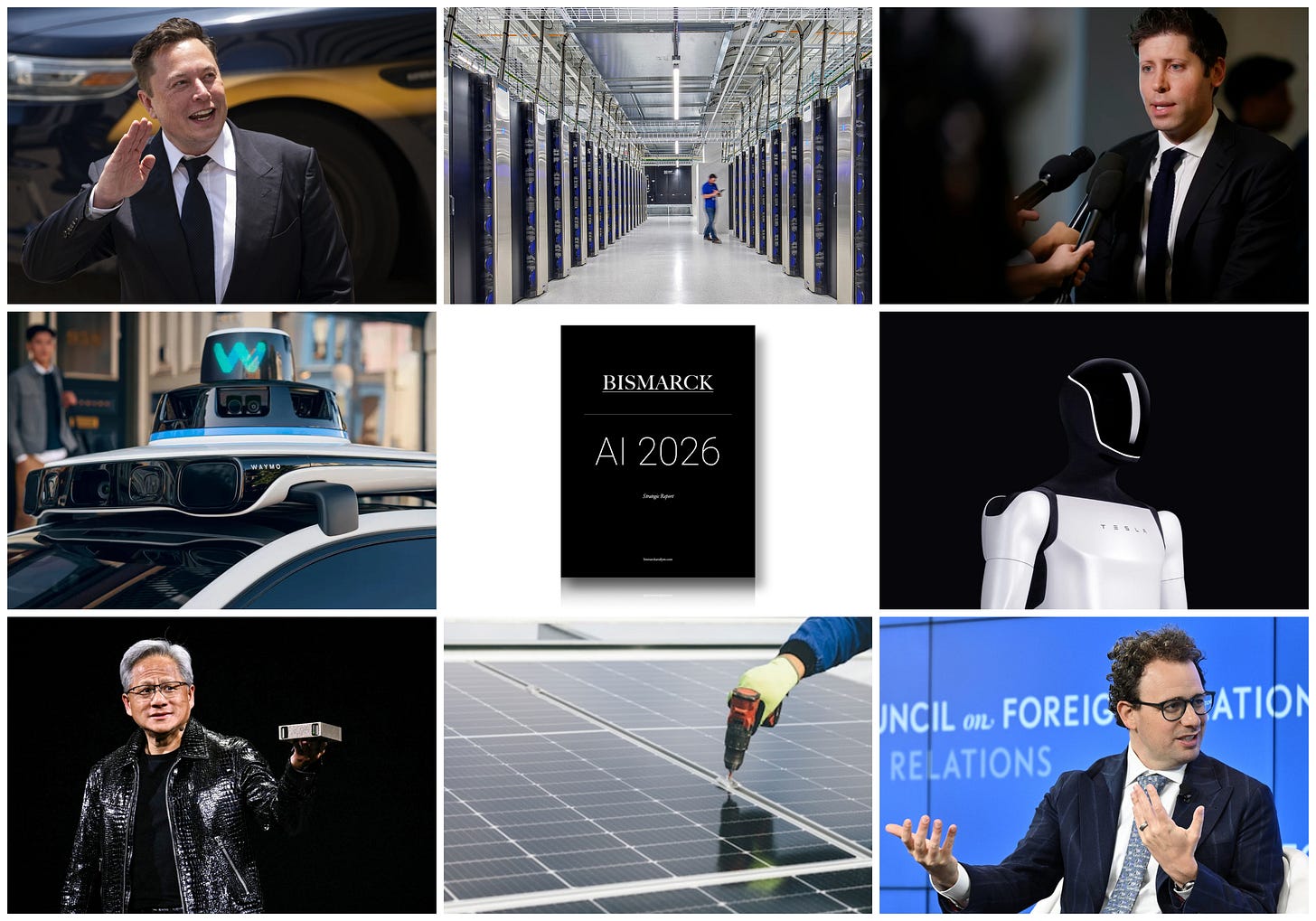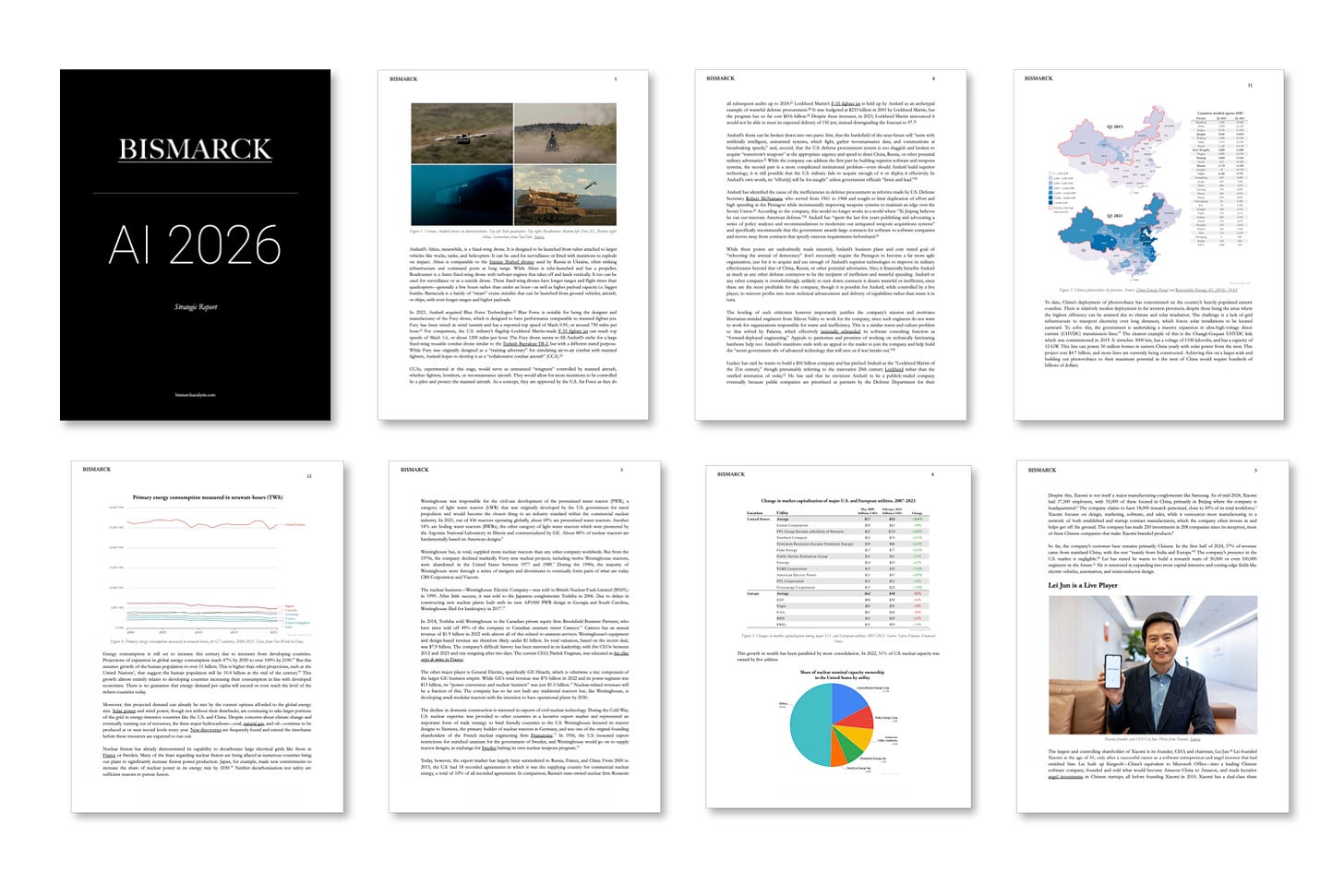Introducing AI 2026: The Global State of Play
In our upcoming AI 2026 Bismarck Strategic Report, we will provide in-depth analysis of all the world's leading artificial intelligence labs, as well as the companies and live players behind them.
Many of our world’s most formidable live players including Elon Musk, Sam Altman, and Bill Gates, as well as many cornerstone institutions of our society ranging from investment banks to the U.S. government, are betting their own economic and strategic futures on rapid near-term advancements in artificial intelligence technologies. The potential consequences of such breakthroughs are furthermore so profound that they merit close analysis in and of themselves. If achieved, such advances in AI will provide intelligence “too cheap to meter,” and through it unlock all other possible technological advancements as well as deliver unimaginable material wealth. AI pioneers such as Nobel laureate Geoffrey Hinton further believe such artificial intelligences will ultimately pose a remarkable risk to humanity, possibly even heralding the end of our time as the dominant species on Earth.1
While not everyone believes in the alternatively catastrophic or utopian transhumanist-inspired visions held by the technologists driving these developments, it is on some level a moot point, because these dizzying possibilities unlocked by AI have already captured the imaginations of the world’s most powerful economic and political institutions. Indeed, since the viral launch of ChatGPT by OpenAI in November 2022, we have witnessed three years of an escalating, almost all-of-society effort to harness the potential of AI for massive economic returns. The potential promise of AI to ameliorate or solve deep-seated problems like deindustrialization, demographic decline, or debt-funded entitlements is simply too tempting to ignore, and thus the question of AI touches on every facet of our society.
Already in June 2024, major corporations, tech giants, and utilities were set to spend around $1 trillion on capital expenditures such as data centers, chips, and the power grid to support them in the coming years.2 These expenditures were all financed with an unprecedented leveraging of financial resources from the richest people in the world, sovereign wealth funds, investment banks, and investment holding companies such as SoftBank, even with the backing of governments. So far, as of October 2025, the investment shows no signs of slowing down, with many more hundreds of billions of dollars invested. It is not just Silicon Valley software engineers or Wall Street financiers who are now asking themselves what their AI strategy is, but policymakers in Washington, party officials in Beijing, military planners in Moscow, civil servants in Brussels, and leaders hungry for development and growth from Paris and London to Abu Dhabi and New Delhi.
This immense spending has been facilitated by vast capital reallocation, which is perhaps best measured in the spectacular rise of the valuations of both publicly and privately traded companies tied to the industry. Such companies include those that are manufacturing and developing advanced chips such as TSMC, AMD, or Nvidia. It also includes companies building supporting infrastructure and data centers such as Amazon or Oracle, and of course AI labs themselves that are making mathematical and theoretical advances in AI such as OpenAI, DeepSeek, Meta, Google, xAI, Mistral, and Anthropic. It includes companies speculated to benefit from advances in AI via new hardware like humanoid robots or self-driving cars too, such as Tesla, Figure, or Xiaomi. Nearly all relevant companies span multiple categories as they try to organize the entire emerging technological stack, from silicon to inference, to their own advantage, and make deals to help finance themselves and secure further investments.
These valuations continue to reach new heights. Nvidia became the first company in history to reach a market capitalization of $4 trillion in early July 2025. By the end of July, Microsoft had become the second company to pass that milestone. Companies such as Alphabet, Amazon, Meta, and Oracle all hit their own all-time highs denominated in trillions of dollars. Is it so unthinkable now that one of these companies will soon become the first $10 trillion company? And one of the founders or executives of these companies the first trillionaire? These spectacular valuations are correlated with each other much more deeply than just a shared bet on a technological gold rush.
There are significant multi-billion-dollar cross-investments and complicated mutual ventures undertaken by these major infrastructure providers. Just last month, for example, Nvidia announced it will invest up to $100 billion dollars into their customer OpenAI, as the leading AI lab also deploys huge amounts of Nvidia systems.3 Nvidia CEO Jensen Huang then in turn publicly expressed surprise when, not long after, OpenAI signed a multi-year chip supply deal with his competitor AMD, where OpenAI was given the option to buy up to a 10% stake in the chip supplier.4 OpenAI CEO Sam Altman has stated more such deals are in the works, with OpenAI already investing in their suppliers such as Nvidia, AMD, Oracle, and Broadcom.
This brave new world of data center financing, where sellers are subsidizing buyers, has raised concern from financial observers for how seemingly circular some of the deals are. Many of the commitments that collectively run into the trillions of dollars that are now being made are paid for not with revenue but with increases in the value of publicly or privately traded stock, appreciations driven by the announcements of the deals themselves.5 The AI industry has now grown to such an extent that it is likely propping up the world’s largest economy. Without these technology-related categories, U.S. GDP growth in the first half of 2025 reportedly would have been just 0.1% on an annualized basis rather than the 4% it recorded.6 The dollar value contributed to GDP growth by AI data center buildout has reportedly surpassed U.S. consumer spending for the first time ever.7
If, absent our great bet on AI growth, the U.S. economy is already in a recession, this means Western policymakers have a strong incentive to continue supporting further investment into AI, regardless of the technical, financial, or economic fundamentals, just to continue propping up favorable economic figures lest they face severe consequences. In that sense, nearly every asset class has come to be correlated with AI. What does risk diversification even mean in such a macroeconomic environment?
Many Silicon Valley insiders and outside observers have now raised the possibility that we are in a potentially devastating global financial “AI bubble.” Amazon founder Jeff Bezos recently stated that there is in fact an AI bubble, driven by a lack of investor discernment between good and bad ideas, but that it is an industrial bubble, where society will ultimately benefit from the legitimate innovations and infrastructure created.8 It is important to add that even if he is correct in making this distinction it would be of little consolation to hasty investors who stand to lose billions. Either way, bubbles do not pop themselves, but rather just keep growing—and, of all the power players in the world today, in whose interest is it to pop this possible bubble? The answer to this question could easily be the most valuable piece of financial information in recent history.
Those seeking to protect their wealth or seize new growth opportunities will have to go beyond financial sector best practices, textbook answers, and press releases, instead pursuing investment strategies based on completely new thinking. While you might not think you’re interested in AI or that it is irrelevant for your business, family office, or policy work, this societal and economic phenomenon of AI is certain to affect you and your interests. You ignore it at your own risk—and that is even assuming it does not result in new science, advances in robotics, greater automation in manufacturing, and transformations in the military balance of power, all of which are perhaps much likelier outcomes than utopia or catastrophe.
I believe technological breakthroughs in AI and their consequences merit close strategic analysis based on exceedingly accurate rather than incomplete or misleading information. Unfortunately, with so many interested parties trying their best to shape narratives and markets—as well as mislead competitors—the epistemic commons cannot be relied upon. Because of this, I am convinced that today, more than ever, navigation-grade analysis should be made available to the hundreds of key live player decision-makers who help steer our civilization to a better future.
We at Bismarck Analysis have been closely following and advising key players in the development of artificial intelligence since our founding in 2017, five years before the AI boom began in earnest. Through our firm’s near-decade of strategic consulting and research commissioned by top AI industry insiders, many of whom have since become household names, our firm has developed unparalleled, deep expertise across technology, economics, politics, business, and strategy to deliver accurate analysis that does not overlook the implications of any of those aspects, something truly unique among the research organizations and consulting firms in any industry today.
Our confidential work for our private clients over the years has reviewed the entire semiconductor manufacturing supply chain from optics through chip design, the geopolitical dynamics of AI competition and cooperation, the likely energy fundamentals of an AI revolution and their consequences, the key scientists working on AI technology, and the financial interests and flows funding the sector. Both top investors and CEOs have relied on us to guide their investment, philanthropic, business, and political strategies.
Our more publicly-accessible work, namely Bismarck Brief, is moreover already a trusted and relied-upon wealth of knowledge and intelligence on the AI landscape. We have already examined multiple players in every layer of the AI technological stack, including energy, minerals, semiconductor manufacturing, chip design, software, hardware, and the AI labs themselves. This was not done through trend-chasing or by happenstance, but it instead came about through following a systematic, multi-year research plan aimed at mapping out and forecasting the technological landscape of one of the most important developments of our era. Over the course of the coming months, we will continue to methodically investigate the key organizations and live players relevant to AI, releasing some of these as case studies to our Bismarck Brief subscribers, which you can read at our new AI 2026 segment.
More importantly, because of the immense importance of accurate information about and deep analysis of these developments, we will for the first time ever offer an exclusive annual comprehensive report going even further beyond the scope of our Briefs, titled AI 2026: Bismarck Strategic Report. At an estimated final length of between 225 to 275 pages, this industry-grade document will feature all of the information and analysis a live player needs to navigate this new AI-driven world:
In-depth case studies of all the world’s frontier AI labs, including both U.S. giants like OpenAI, Anthropic, and Google as well as Chinese upstarts like DeepSeek and Moonshot AI.
Player profiles of all the key figures in the AI boom, such as Sam Altman, Demis Hassabis, Bill Gates, Mark Zuckerberg, Larry Ellison, and Elon Musk—examining their personal ideologies, backgrounds, capabilities, and goals.
Up-to-date data presentation and analysis on data center construction, electricity consumption, and energy build-out potential in the U.S., China, Europe, and Arab Gulf states.
List and evaluation of key AI scientists and living traditions of knowledge advancing the field, also reviewing the relative strength of different countries’ mathematical traditions to help gauge where new AI researcher talent is likely to come from in the near future.
Analysis of key players providing capital to fund AI development, including major cloud providers like Microsoft and AWS, venture capitalists, and governments.
Analysis of all key players in the semiconductor design and manufacturing stacks including Nvidia, TSMC, ASML, and Carl Zeiss, as well as rising Chinese domestic challengers and others.
Overview of key domains where progress in AI is expected to have near-term transformative impact, including robotics, autonomous vehicles, and drone warfare.
Analysis of geopolitical implications of various AI scenarios, examining impacts on the balance of power between the U.S., China, Europe, Russia, and other states.
An opening first-principles analysis as well as a concluding letter to live players by our founder and president Samo Burja, synthesizing and summarizing key recommendations for executive decision-making and providing grounding in the big picture takeaways.
This new annual strategic report will feature our signature crisp style and analysis, extensive sourcing for further reading, and custom-made charts, tables, and graphics to aid understanding. It will be delivered on January 30, 2026 to help set the next year’s strategic goals. Similar comprehensive reports have been previously reserved for our most valued clients such as corporate partners and high-net worth individuals, or have been very rarely released publicly such as our white papers on nuclear nonproliferation (2018) and machine tools manufacturing (2020).
In order to purchase access to AI 2026: Bismarck Strategic Report, simply upgrade or become a paid subscriber to Bismarck Brief at the new AI 2026 tier using the button below:
Subscribers will also receive full access to our catalog of 200+ Briefs investigating the world’s most strategically relevant live players, institutions, and industries, as well as new Briefs in their inbox over the coming weeks and months—including Briefs that will contribute to the final AI report—every Wednesday at 2pm GMT sharp. To get the most value from our ongoing and methodical research, do not delay, but make sure to subscribe immediately and never miss a word. Those already subscribed at the previously-named Client tier will of course receive complimentary access to AI 2026 and do not need to take any action.
If you are interested in hiring us for additional customized research and in-depth strategic consulting on AI, please contact us here or reply to this email. If you do not wish to purchase access to the full AI 2026 report, but you wish to become a paid subscriber to Bismarck Brief, click the button below and simply subscribe at the monthly or annual rates:
I look forward to hearing the thoughts of our sophisticated and intelligent readership on this unprecedented and unique investigation into the economic and political landscape of artificial intelligence.
Sincerely,
Samo Burja
Founder and President, Bismarck Analysis
“Gen AI 2.0: Too Much Spend, Too Little Benefit?”, Goldman Sachs, June 25, 2024, https://www.goldmansachs.com/images/migrated/insights/pages/gs-research/gen-ai--too-much-spend,-too-little-benefit-/TOM_AI%202.0_ForRedaction.pdf
“OpenAI and NVIDIA Announce Strategic Partnership to Deploy 10 Gigawatts of NVIDIA Systems,” Nvidia Newsroom, September 22, 2025, https://nvidianews.nvidia.com/news/openai-and-nvidia-announce-strategic-partnership-to-deploy-10gw-of-nvidia-systems
Julie Bort, “Even after Stargate, Oracle, Nvidia, and AMD, OpenAI has more big deals coming soon, Sam Altman says,” TechCrunch, October 8, 2025, https://techcrunch.com/2025/10/08/even-after-stargate-oracle-nvidia-and-amd-openai-has-more-big-deals-coming-soon-sam-altman-says/
Andrew Ross Sorkin et al., “Is A.I. Investment Getting Too Circular?”, The New York Times, October 7, 2025, https://www.nytimes.com/2025/10/07/business/dealbook/openai-nvidia-amd-investments-circular.html
Nick Lichtenberg, “Without data centers, GDP growth was 0.1% in the first half of 2025, Harvard economist says,” Fortune, October 7, 2025, https://fortune.com/2025/10/07/data-centers-gdp-growth-zero-first-half-2025-jason-furman-harvard-economist/
Nick Lichtenberg, “Spending on AI data centers is so massive that it’s taken a bigger chunk of GDP growth than shopping—and it could crash the American economy,” Fortune, August 6, 2025, https://fortune.com/2025/08/06/data-center-artificial-intelligence-bubble-consumer-spending-economy/




